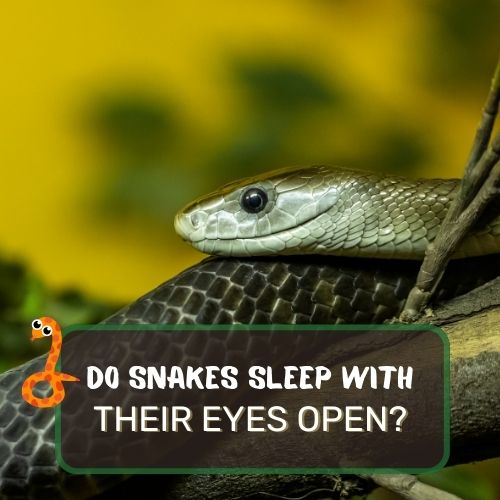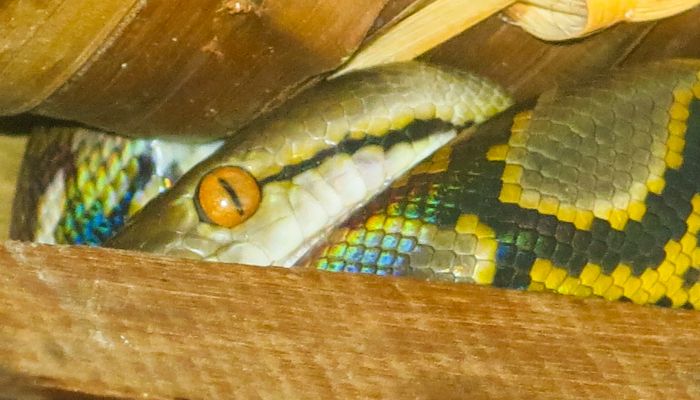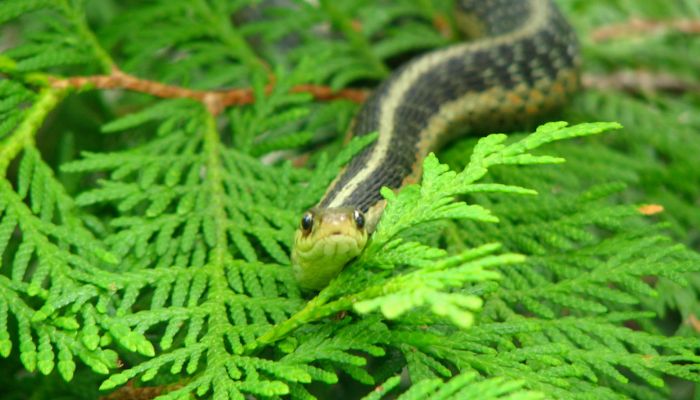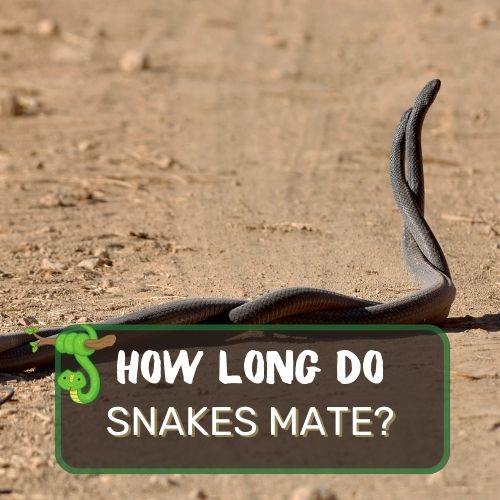
“Do snakes sleep with their eyes open?” It’s a question that has intrigued many, from curious kids to seasoned herpetologists.
At first glance, the unblinking gaze of a snake can be both mesmerizing and mystifying.
In this article, we delve deep into the world of snakes, exploring the unique anatomy of their eyes, the evolutionary reasons behind their unceasing stare, and the mysteries of their sleep patterns.
By journeying through this article, readers will gain insights into the fascinating adaptations of these reptiles, uncovering the reasons behind their ever-watchful eyes.
Whether you’re a snake enthusiast or just someone intrigued by nature’s wonders, this article promises a captivating exploration of one of nature’s most enigmatic creatures.
Table of Contents
Do Snakes Sleep With Their Eyes Open? (Yes, They Do)
Yes, snakes do sleep with their eyes open. The reason behind this unique behavior is that snakes lack eyelids. Instead of traditional eyelids, they have a transparent scale called the “brille” that covers and protects their eyes. This scale ensures their eyes remain moist and shielded from debris. As a result, snakes cannot blink or close their eyes, making it appear as though they are always awake. However, despite their open-eyed appearance, snakes can indeed enter a state of rest or sleep, relying on secluded and safe spots to minimize disturbances during their slumber.
The Evolution of Snake Eyes

The animal kingdom is a vast tapestry of evolutionary marvels, and snakes are no exception. Their eyes, in particular, are a testament to nature’s ingenuity and adaptability.
Let’s dive deeper into the evolutionary journey of snake eyes and uncover the mysteries behind their unique features.
Why snakes don’t have eyelids
Imagine being in a world where blinking is a luxury. For snakes, this is a reality. Unlike most creatures, snakes evolved without the need for eyelids.
But why?
The answer lies in their survival instincts. In the wild, every moment counts. The split second it takes to blink could mean the difference between life and death.
By not having eyelids, snakes can remain ever vigilant, always on the lookout for both prey and predators.
Description of the brille and its function
The term “brille” might sound like a fancy French accessory, but for snakes, it’s a crucial part of their anatomy.
The brille is a transparent scale that covers a snake’s eyes. Think of it as nature’s contact lens. It serves a dual purpose: protection and hydration.
Without the ability to blink, snakes needed a way to keep their eyes moist and safe from debris. The brille does just that, ensuring their eyes remain clear and functional.
How it’s a modified version of regular snake scales
Every part of a snake is a marvel of evolution, and the brille is no different. While it might seem like a unique structure, it’s essentially a modified version of the regular scales that cover a snake’s body.
Over time, as snakes evolved, this particular scale adapted to become transparent and took on the vital role of protecting the eye.
The shedding process of the brille
Just like snakes shed their skin, they also shed the brille. As a snake grows, its old skin becomes restrictive, and a new layer forms underneath.
This process is known as ecdysis. The brille, being a specialized scale, is also part of this shedding process.
So, when a snake sheds its skin, it’s also getting a fresh, new brille. It’s like getting a brand-new pair of contact lenses every few weeks!
How snakes adapted to live alongside hungry dinosaurs
The prehistoric era was a challenging time for snakes. With massive, hungry dinosaurs dominating the landscape, these slender reptiles had to find a way to survive. Their eyes played a crucial role in this.
By not having eyelids and being able to constantly scan their surroundings, snakes could quickly slither away at the first sign of danger. Their keen vision allowed them to spot threats from afar and react swiftly.
The move toward a nocturnal lifestyle
But merely being vigilant wasn’t enough. To further enhance their chances of survival, many snake species transitioned to a nocturnal lifestyle.
The cover of darkness provided an added layer of protection against predators. This nocturnal shift also influenced the evolution of their eyes.
The need to see in low light conditions led to the development of larger, more light-sensitive eyes. The brille, with its transparent nature, further aided in maximizing the amount of light entering the eye.
In the grand tapestry of evolution, the story of snake eyes is a captivating chapter. It’s a tale of survival, adaptability, and nature’s endless ingenuity.
The Mystery of Snake Sleep

Ah, sleep. That blissful state of rest that every creature, from the tiniest ant to the largest whale, indulges in.
But when it comes to snakes, the concept of sleep takes a mysterious turn. Let’s unravel the enigma of how these legless reptiles catch their forty winks.
How snakes manage to sleep without closing their eyes
Imagine trying to sleep with your eyes wide open in a bustling city. The lights, the noise, the constant movement—it seems impossible, right?
Yet, for snakes, this is just another day (or night) in their life. Without the luxury of eyelids, snakes have mastered the art of sleeping with their eyes open. But how?
The environment plays a role. Snakes often seek out quiet, secluded spots to rest. These can be under rocks, inside burrows, or amidst dense foliage.
Here, the lack of visual stimuli allows their brain to switch off, even if their eyes remain open. It’s akin to us sleeping in a pitch-black room. The darkness acts as a blanket, cocooning them in rest.
The role of the reptilian brain in this process
The reptilian brain, the oldest part of the brain, is responsible for basic survival instincts like aggression, dominance, territoriality, and ritualistic behaviors. In snakes, this brain plays a pivotal role in their unique sleep patterns.
The reptilian brain allows snakes to enter a state of rest while still being alert to potential dangers. It’s a fine balance between deep rest and vigilance.
This means that even in slumber, a part of the snake’s brain remains active, processing information from the eyes and other senses. If a threat is detected, the snake can spring into action in a heartbeat.
The advantage of snakes sleeping with their eyes open
For snakes, sleeping with their eyes open isn’t just a quirky trait—it’s a survival mechanism. In the wild, danger lurks around every corner. A prowling predator, an unexpected threat, or even a sudden change in the environment can spell doom.
By keeping their eyes open, snakes maintain a continuous connection with their surroundings. It’s their way of ensuring they’re never caught off guard.
Comparing it to the human concept of “sleeping with one eye open”
We’ve all heard the phrase “sleeping with one eye open,” especially when we’re in unfamiliar or uncomfortable situations. It’s our way of saying we’re alert, even in rest. For snakes, this isn’t just a saying—it’s a way of life.
While we might use it metaphorically, for snakes, it’s a literal reality. It’s a testament to their resilience and adaptability, traits that have ensured their survival for millions of years.
Further Evolution of Snake Eyes

Nature is an artist, constantly refining its creations. In the case of snakes, their eyes are a canvas that has seen countless evolutionary brushstrokes.
From the absence of eyelids to the intricate design of their lenses, the eyes of snakes are a testament to nature’s ingenuity. Let’s delve deeper into the fascinating journey of the evolution of snake eyes.
Changes Due to Lack of Protective Eyelid
In the grand scheme of evolution, the absence of eyelids in snakes wasn’t a mere oversight; it was a deliberate design choice.
But this unique feature came with its own set of challenges. Without the protective shield of an eyelid, the snake’s eyes were exposed to the elements—dust, debris, and potential injuries.
To counter this, nature equipped snakes with the brille, a transparent scale that serves as a protective barrier. But the evolution didn’t stop there.
The constant exposure to light, especially harsh sunlight, meant that the snake’s eyes had to develop additional protective mechanisms.
This led to the evolution of specialized lenses and unique pupil designs, tailored to the snake’s lifestyle and environment.
Differences between diurnal and nocturnal snake lenses
Just as humans have different preferences for day and night activities, snakes too have their own circadian rhythms.
Depending on whether they’re active during the day (diurnal) or night (nocturnal), their eyes have evolved differently.
Diurnal snakes, basking in the sunlight and hunting during the day, have lenses that are adept at filtering out excessive light.
This ensures that their vision isn’t overwhelmed by the brightness of the day. On the other hand, nocturnal snakes, which come alive in the moonlit night, have lenses designed to maximize light intake.
Their lenses are transparent, allowing them to see even in the dimmest of lights, making them efficient hunters in the dark.
The protective features of the yellow lens in diurnal snakes
The yellow lens in diurnal snakes isn’t just for show—it’s a protective mechanism. Just as we don sunglasses to shield our eyes from harmful UV rays, the yellow lens in these snakes performs a similar function.
It filters out harmful ultraviolet radiation, ensuring that the snake’s retina remains unharmed. This yellow tint also enhances contrast, allowing the snake to spot prey and predators with ease, even in the bright daylight.
Pupil Constriction in Nocturnal Snakes
The night holds many mysteries, and for nocturnal snakes, their eyes are the key to unraveling them. One of the most fascinating features of nocturnal snake eyes is their ability to constrict their pupils.
Imagine adjusting the aperture of a camera to control the amount of light entering it. The pupil constriction in nocturnal snakes works on a similar principle.
In the presence of bright light, such as the glow of a full moon, the snake can constrict its pupil, reducing light intake and preventing overexposure.
Conversely, in low light conditions, the pupil dilates, maximizing light entry and ensuring the snake has optimal vision.
This ability to control light intake, combined with their transparent lenses, makes nocturnal snakes master hunters of the night, capable of seeing even the slightest movement in the dark.
Insights into Snake Evolution

The intricate dance of evolution is a tale as old as time itself. Every species, every organism, carries with it a story of adaptation, survival, and transformation. Snakes, with their legless bodies and mesmerizing eyes, are no exception.
Delving into the evolution of snake eyes offers a window into the broader evolutionary journey of these fascinating reptiles.
How studying snake eyes provides insights into their evolutionary history
Eyes are often called the windows to the soul. In the case of snakes, they’re also windows to their ancient past.
By studying the structure, function, and adaptations of snake eyes, scientists can piece together the evolutionary puzzle of these creatures.
For instance, the absence of eyelids and the presence of the brille hint at a time when snakes needed to be ever-vigilant, always on the lookout for threats.
The differences in lenses between diurnal and nocturnal snakes give clues about their ancestral hunting patterns and lifestyles.
Even the unique pupil designs, from vertical slits to round shapes, offer insights into the environments snakes once inhabited and the challenges they faced.
In essence, every feature of a snake’s eye is like a chapter in a history book, narrating tales of survival, adaptation, and evolution.
The role of eye evolution in snakes adapting to different climates and environments
As Earth’s landscapes transformed over millennia—forests turning into deserts, mountains rising from plains, and ice ages coming and going—snakes had to adapt or perish.
Their eyes played a pivotal role in this adaptation.
In the dense rainforests, where light filters through thick canopies, snakes developed eyes that could capture even the faintest glimmers of light.
In the harsh deserts, where the sun blazes with unforgiving intensity, snakes evolved eyes with protective features, like the yellow lens, to shield against UV radiation.
The ability of some snakes to constrict or dilate their pupils allowed them to inhabit diverse environments, from sunlit terrains to shadowy undergrowths.
This adaptability ensured that snakes could thrive in various climates, from the humid tropics to the cold temperate zones.
Furthermore, the evolution of their eyes also influenced their behavior and feeding patterns. Snakes in brightly lit environments, with eyes adapted to filter excessive light, became diurnal hunters.
In contrast, those in dimly lit habitats, with eyes designed for low light vision, took on nocturnal lifestyles.
Conclusion
The world of snakes, with its myriad mysteries and wonders, has always captivated human imagination.
From their unique anatomy to their intriguing behaviors, every facet of their existence offers insights into the marvels of evolution. As we’ve journeyed through the story of snake eyes, several key points have emerged:
- The absence of eyelids in snakes is not a mere evolutionary oversight but a testament to their need for constant vigilance.
- The brille, a transparent scale, serves as a protective shield for their eyes, ensuring they remain moist and safe from external threats.
- Evolutionary pressures, such as the presence of predatory dinosaurs, influenced the nocturnal tendencies of snakes and, consequently, the design of their eyes.
- The differences in the lenses of diurnal and nocturnal snakes highlight their adaptability to diverse environments and light conditions.
- The evolution of snake eyes, from their protective features to their unique pupil designs, provides a window into the broader evolutionary journey of these reptiles.
Yet, for all we know, the realm of snakes still holds many secrets. The very fact that they can sleep with their eyes open, a concept so alien to human understanding, underscores the continued mystery surrounding these creatures.
Their eyes, ever watchful and unblinking, are a source of endless fascination, prompting us to delve deeper, ask more questions, and seek further understanding.
FAQ
Can snakes still see when they sleep?
While snakes have their eyes open when they sleep, it doesn’t necessarily mean they’re processing visual information as they would when awake. Their brain enters a rest state, and while they might detect changes in light or sudden movements, they aren’t “seeing” in the traditional sense.
How do snakes sleep?
Snakes enter a state of rest similar to sleep in other animals. Due to their reptilian brain, they can remain alert to potential dangers even while resting. They often seek out quiet, secluded spots to rest, ensuring minimal disturbance.
Do snakes keep their eyes open when they sleep?
Yes, snakes sleep with their eyes open. This is because they lack eyelids. Instead, they have a transparent scale called the brille that protects their eyes. So, while it may seem like they’re always awake, they can be deep in slumber even with their eyes wide open.
Can snakes close their eyes?
No, snakes cannot close their eyes because they don’t have eyelids. Their eyes remain perpetually open, protected by the brille. This unique feature is a result of their evolutionary journey and the specific challenges and needs they faced along the way.




0 Comments